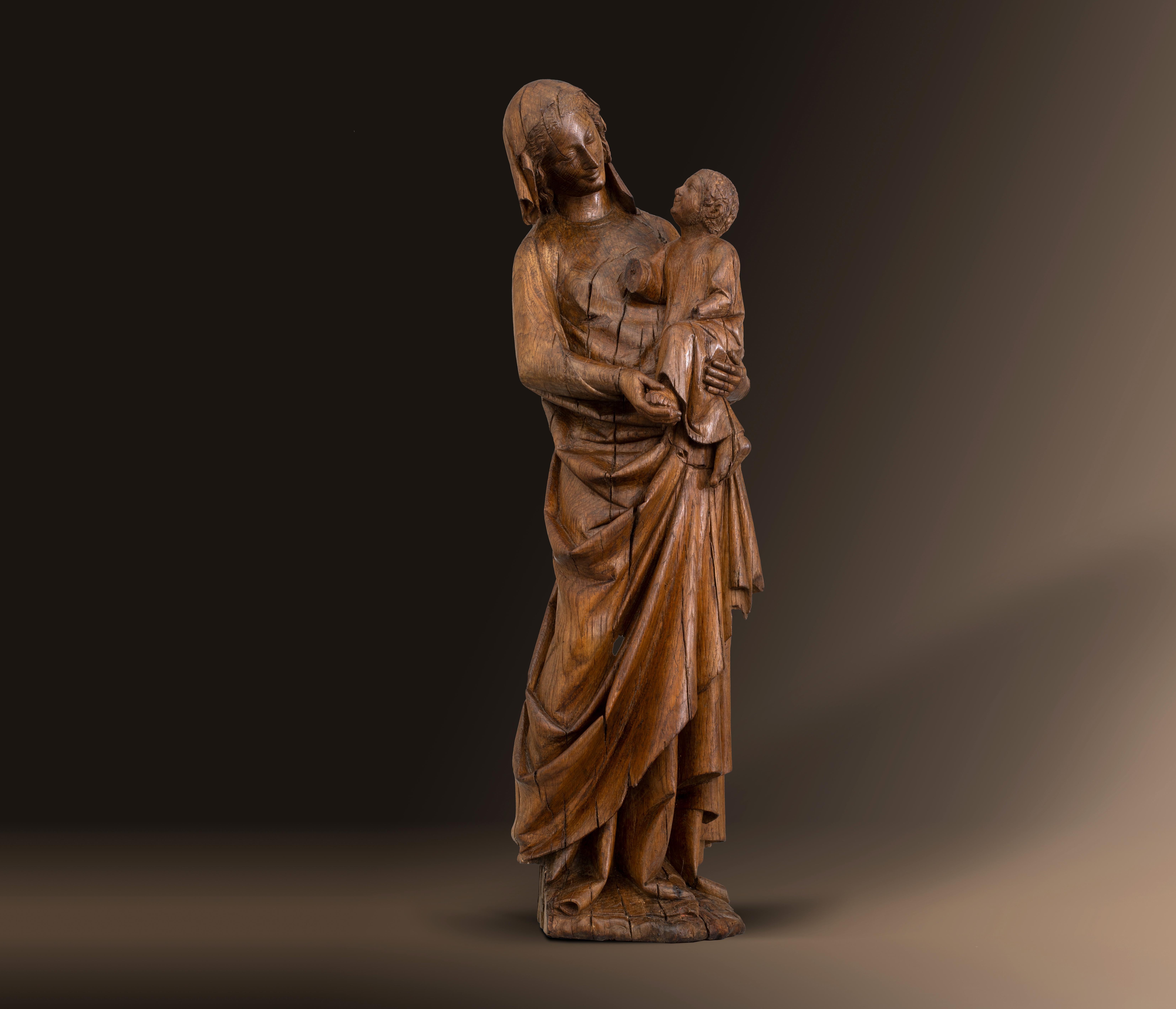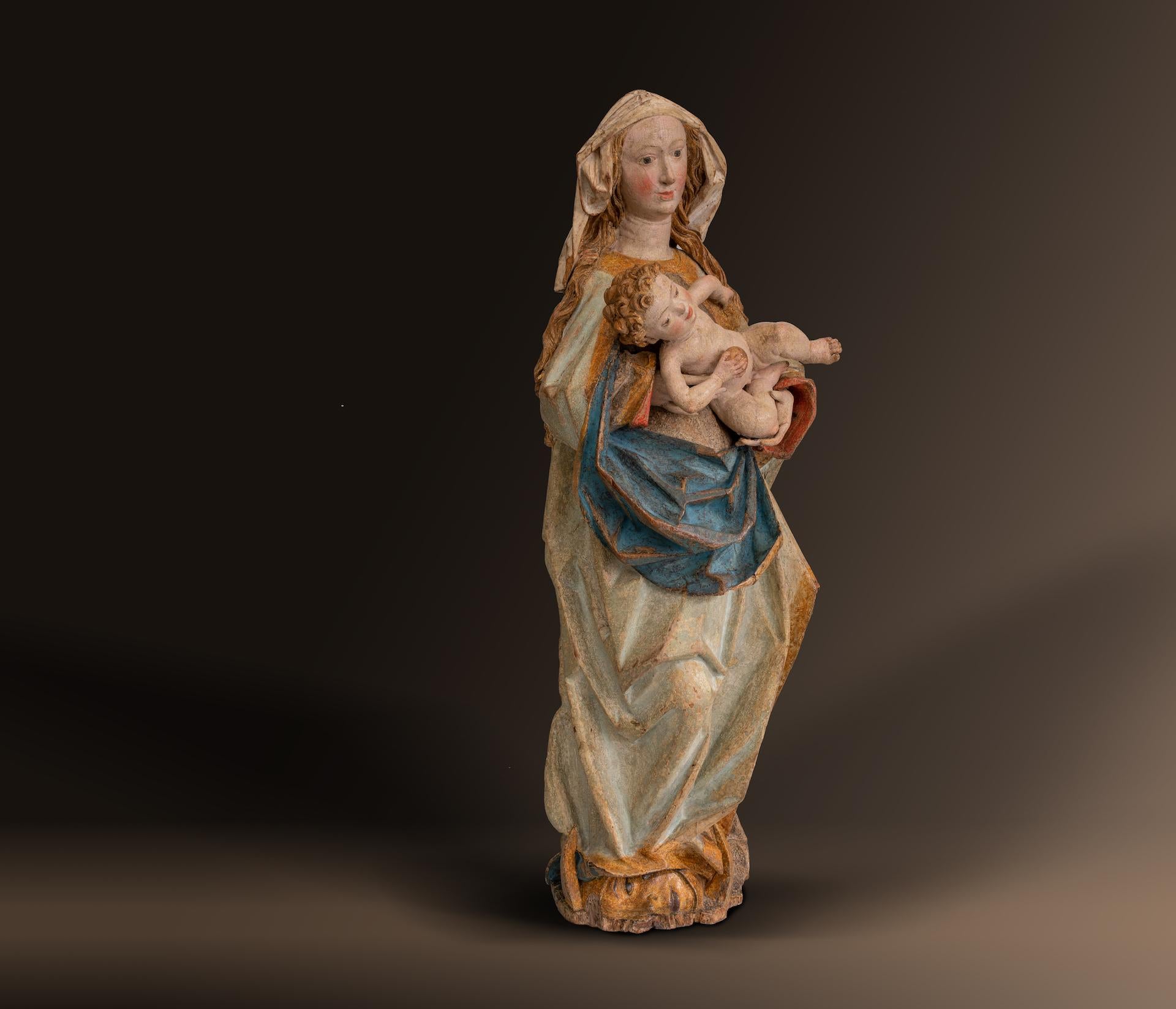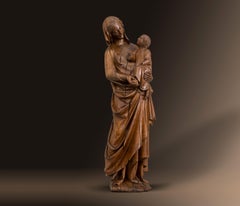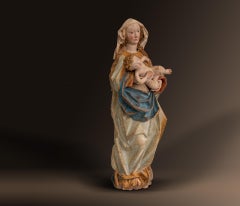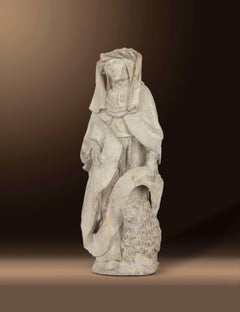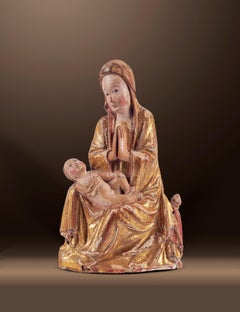Want more images or videos?
Request additional images or videos from the seller
1 of 6
Mark MorrisonMadonnaca. 1940
ca. 1940
$1,600
$4,00060% Off
£1,231.45
£3,078.6360% Off
€1,402.41
€3,506.0160% Off
CA$2,274.64
CA$5,686.5960% Off
A$2,472.61
A$6,181.5160% Off
CHF 1,295.86
CHF 3,239.6660% Off
MX$30,093.72
MX$75,234.2960% Off
NOK 16,311.82
NOK 40,779.5660% Off
SEK 15,327.81
SEK 38,319.5260% Off
DKK 10,473.17
DKK 26,182.9360% Off
About the Item
Mark Morrison (1895-1964)
Madonna, ca. 1940
Carved stone
7" wide, 5" deep, height is 4.5"
Provenance: Estate of Mrs. Mark Morrison.
Born:
Kingfisher, OK
Education:
University of Missouri
John Flannagan, mentoring and private instruction ca. 1940
Art Students League with William Zorach and Jose de Creeft
Exhibited:
Sculpture Guild Annuals
Audubon Artists Annuals
National Academy of Design Annuals
Pennsylvania Academy Annuals
Metropolitan Museum Artists for Victory, 1942.
Newark Fine Arts Museum
Whitney Annuals
International Exhibition, Fairmount Park, Phila. 1950
Nebraska Fine Arts
Metropolitan Museum Exhibition, 1951
Boston Arts Festival
National Sculpture Society Annuals
Memberships:
Sculpture Guild, Inc.
Audubon Artists
Awards:
Ellen Prince Speyer Award, N.A. 1950
Architects League of New York, Avery Award, 1958, 1959.
Museum Collections:
Metropolitan Museum of Art
National Academy of Design
Pennsylvania Academy of Fine Arts
Whitney Museum of American Art.
Museum of Fine Arts, University of Arizona
Mark Morrison began his life as a sculptor while nearing his professional retirement. In the late 1930s and into the 1940s, he like many of the younger artists in New York City availed himself to the great many academies, museums, teachers and mentors it offered. He studied with John Flannagan before his death, and then Jose de Creeft and Williams Zorach at the Art Students League. Having an attraction and aptitude for the ideas of the direct carving movement and good thorough craft, he took advantage of the growing public interest in a new American sculpture, and worked quickly to become a contemporary of his teachers. Through the 1950s, he exhibited with them, sold, entered competitions, and won awards. He was a sculptor with a sure hand, a head for academy, patience, and promise. Morrison died suddenly in October 1964 having had just married his second wife earlier the same year. Mrs. Mark Morrison would offer a small piece for one more exhibition with a Sculptors Guild in 1965. The work was never seen again until 2025.
Morrison was born on New Year’s Day in 1895 in Kingfisher, Oklahoma, a small rural city not yet a part of the Union. The only child of a Protestant minister, and one of only 16 that in 1913 would graduate from his high school in Higginsville, Missouri. He studied agriculture at the University of Missouri, at some point leaving to enlist in the army. He would reach the rank of Major. After the war, he married his first wife, moved to New York and began work for Tidewater Oil. He worked with them until 1954, retiring as a vice president. At the time he was living at 8 W. 13th St., his studio already set up in a corner of the basement in his apartment building.
The earliest exhibition on record for a work by Morrison was the Artists for Victory show at the Metropolitan Museum, 1942. Earlier the same year, John Flanagan committed suicide. The death was a terrible blow. Flannagan had been a profound influence, sharing both technical instruction and philosophical guidance. The importance of their friendship during the 1930's cannot be overemphasized. Morrison is part of Flannagan's artistic legacy, his only known pupil during the mythical sculptor's short life. Born in the same year of 1895, both artists came to NYC from rural regions of the US: Oklahoma and North Dakota respectively. In contrast to Morrison's stable life, Flannagan was a deeply troubled, difficult, impatient and unpredictable man. To have considered mentoring Morrison, his teacher must have seen a kindred spirit and artist of extraordinary potential. In turn, Morrison must have been a sympathetic and patient pupil who recognized the importance of overlooking personal shortcomings for the invaluable instruction of an artistic genius.
Morrison did not show regularly for almost 10 years spending this time educating himself, exhibiting here and there. He continued his sculpture studies at the Art Student League with Zorach and de Creeft, spending most nights working stones in his studio. His mature style would become clearly realized by 1950, a synthesis of the naïve and the sophisticated, what Flanagan called "the image in the rock", and the polished fluid marbles of Zorach.
Black Swan was featured in the Sculptors Guild exhibition "In Time and Place" at the Museum of Natural History in March 1952. And exhibit pushing those points in their mission to assist the public to fuller appreciation of sculpture, and that the sculpture and the architecture of buildings may again be planned simultaneous and homogeneously. Morrison's swan was the centerpiece of the modern living room designed by Earnshaw, Inc. In the same hall of the museum one year earlier Morrison and other members of the group demonstrated process at work in seven makeshift studios. He would continue to exhibit in Guild annuals and Audubon Artist annuals. His sculpture "Gosling" was given a special honorable mention from the Architects League in the Avery Competition of 1958, runner up to Zorach. In 1959, when he showed "Grasshopper" he won outright.
He had moved his studio to a larger more private space a few blocks away in Greenwich Village. By 1964 his work had become larger in scale, his groupings more challenging and lively, more considerate of light and the nature of the stone itself. He had lost weight and for a man of nearly 70 years old was in very good health. His death was unexpected and unfortunate, probably of a stroke . His legacy has survived, largely unknown until now in a small ranch in upstate New York.
- Creator:Mark Morrison (1895 - 1964, American)
- Creation Year:ca. 1940
- Dimensions:Height: 4.5 in (11.43 cm)Width: 7 in (17.78 cm)Depth: 4 in (10.16 cm)
- Medium:
- Movement & Style:
- Period:
- Condition:
- Gallery Location:Wilton Manors, FL
- Reference Number:1stDibs: LU245216298162
About the Seller
4.9
Platinum Seller
Premium sellers with a 4.7+ rating and 24-hour response times
Established in 2007
1stDibs seller since 2015
429 sales on 1stDibs
Typical response time: 5 hours
- ShippingRetrieving quote...Shipping from: Reading, PA
- Return Policy
Authenticity Guarantee
In the unlikely event there’s an issue with an item’s authenticity, contact us within 1 year for a full refund. DetailsMoney-Back Guarantee
If your item is not as described, is damaged in transit, or does not arrive, contact us within 7 days for a full refund. Details24-Hour Cancellation
You have a 24-hour grace period in which to reconsider your purchase, with no questions asked.Vetted Professional Sellers
Our world-class sellers must adhere to strict standards for service and quality, maintaining the integrity of our listings.Price-Match Guarantee
If you find that a seller listed the same item for a lower price elsewhere, we’ll match it.Trusted Global Delivery
Our best-in-class carrier network provides specialized shipping options worldwide, including custom delivery.More From This Seller
View AllMonkey
Located in Wilton Manors, FL
Mark Morrison (1895-1964)
Monkey, ca. 1940
Carved New Hampshire granite
8.5" by 5", height is 16.5"
Provenance: Estate of Mrs. Mark Morrison.
Born:
Kingfisher, OK
Education:
...
Category
Mid-20th Century Realist Sculptures
Materials
Granite
$4,000 Sale Price
50% Off
Chipmunk
Located in Wilton Manors, FL
Mark Morrison (1895-1964)
Chipmunk, ca. 1940
Italian granite
5" by 4", height is 4 1/8"
Provenance: Estate of Mrs. Mark Morrison.
Born:
Kingfisher, OK
Education:
Universit...
Category
Mid-20th Century Realist Sculptures
Materials
Stone
Mountain Goat
Located in Wilton Manors, FL
Mark Morrison (1895-1964)
Mountain Goat, ca. 1940
Carved diorite
3 7/8" wide, 2.5" deep, height is 3"
Provenance: Estate of Mrs. Mark Morrison.
Born:
Kingfisher, OK
Educatio...
Category
Mid-20th Century Realist Sculptures
Materials
Stone
$1,000 Sale Price
50% Off
Embryo Lizard
Located in Wilton Manors, FL
Mark Morrison (1895-1964)
Embryo, ca. 1940.
Carved Italian granite.
12.5" wide, 8.5" deep, height is 5"
Measurement are for stone form alone. It sits 12.5 inches tall at a pitch ...
Category
Mid-20th Century Realist Sculptures
Materials
Granite
$2,400 Sale Price
40% Off
Seated Woman
Located in Wilton Manors, FL
Mark Morrison (1895-1964)
Seated Woman, ca. 1950
Carved and polished red Italian marble
4.75" wide, 6 3/8" deep, height is 16.5""
Provenance: Estate of Mrs. Mark Morrison.
Born...
Category
Mid-20th Century Realist Sculptures
Materials
Stone
$3,500 Sale Price
56% Off
Baboon
Located in Wilton Manors, FL
Mark Morrison (1895-1964)
Baboon, ca. 1940
Carved and weathered Walnut
12" wide, 12" deep, height is 26.5"
Please note the bottom surface is not perfectly flat and the piece lean...
Category
Mid-20th Century Realist Sculptures
Materials
Walnut
$2,500 Sale Price
50% Off
You May Also Like
Madonna
Located in Wien, Wien
MADONNA
Il DE FRANCE/PARIS
Around 1270
Oak wood carved
Height 79cm
Category
15th Century and Earlier Figurative Sculptures
Materials
Oak
Price Upon Request
Madonna
Located in Wien, Wien
MUSEUM SCULPTURE
Master workshop
Hans Klocker
before 1474, possibly in Gais -
After 1500
"CRESCENT MOON"
Around 1480/90
Stone pine wood carved
Original version
Height 77 cm
This ext...
Category
15th Century and Earlier Figurative Sculptures
Materials
Wood
Price Upon Request
Hl. Hieronymus
Located in Wien, Wien
St. Jerome
347 Stridon, Croatia - 420 Bethlehem
Around 1500/20
Limestone
Remains of the original polychromy
Height 45 cm
The man with the holy name!
347 Stridon, Croation – 420 Be...
Category
16th Century Figurative Sculptures
Materials
Limestone
Sitting Madonna
Located in Wien, Wien
Sitting Madonna
Central Italy/Tuscany or Marche
Around 1420
Poplar wood carved
Original version
Height 31 cm
Charming Madonna sculpture from the heyday of the Soft or International...
Category
15th Century and Earlier Gothic Figurative Sculptures
Materials
Wood
Family
Located in Los Angeles, CA
Family, 1976
Martha Tickiq (1939 - 2015)
Baker Lake
Basalt
A wonderful example of this artist's work renown for her figure groups.
Appearing in excellent original condition.
Category
Late 20th Century Sculptures
Materials
Stone
Untitled
Located in Vancouver, CA
Ben McLeod (b. 1948, Aberdeen, Scotland) is a preeminent Canadian sculptor whose over five-decade practice is characterized by a profoundly self-propelled trajectory and the cultivat...
Category
1990s Abstract Figurative Sculptures
Materials
Marble
$3,900
More Ways To Browse
Stone Head Sculpture Hand Carved
Bronze After Botero
Cocoon Sculpture
Gustavo Torres
International Klein Blue
Joel Green
Katherine Jackson
Kaws Bff Black
Kaws Mountain
Kennedy Musekiwa
Leo E Osborne
Metal Sculpture I Beam
Murakami Vinyl
Norma Minkowitz
Outdoor Glass Sculpture
Picasso Bull Ceramic
Picasso Ceramic Poisson
Picasso Madoura Bird
